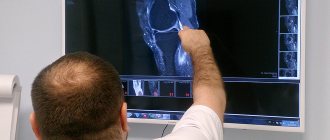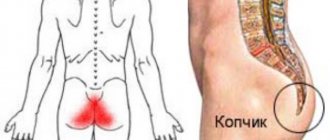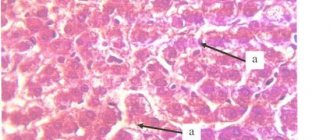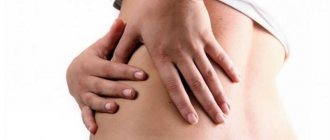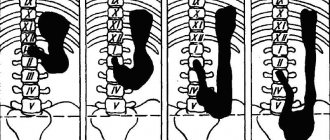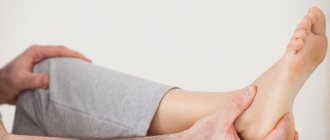What hurts in the left side and what does it mean?
1. Physiological pain in the left side
. Perhaps the most “harmless” signal from the body. Physiological pain can occur as a result of running. The spleen fills with blood and puts pressure on its own membrane, which causes pain. That is why it is necessary to warm up thoroughly before running and maintain even breathing during activity. There is no need to be afraid of such pain, just stop and catch your breath, and when the pain subsides, return to training, slowing down the pace a little.
2. Intestines
. There can be many reasons for pain in the left intestine: intestinal infection, colic, neoplasm growth, irritable bowel syndrome. If the pain is one-time in nature and goes away on its own after a couple of days, there is no need to worry. If the pain continues for more than two days, becomes constant and interferes with normal life, you need to consult a doctor and undergo an examination.
3. Pancreas
. Is the aching pain in your left side constant and worsens after eating? This may be a symptom of chronic pancreatitis, that is, inflammation of the pancreas that occurs due to repeated damage to the organ. If such pain occurs for the first time, but persists for several days, you need to conduct an examination to detect acute pancreatitis.
4. Stomach
. Most of the stomach is located on the left side of the abdominal cavity, so pain associated with this organ most often occurs on the left side. Acute pain in the upper abdomen may indicate gastritis or peptic ulcer. It can occur in both adults and children. Therefore, if a child complains of pain in the left side, he needs to be seen by a doctor immediately.
5. Kidneys
. In diseases associated with the excretory system, pain is often felt in the lumbar region. Severe pain that spreads down the ureter and to the perineum can be caused by renal colic, which occurs when a stone enters the ureter. If the pain is dull, aching, radiating to the lower abdomen, this may be a symptom of pyelonephritis.
Remember that only a specialist can make an accurate diagnosis based on your complaints and the results of additional examinations and tests. Do not panic if pain appears once; anyone can experience it. However, if the pain is accompanied by additional symptoms, then you should pay closer attention to it.
Diagnostics
Patients with complaints of heaviness in the hypochondrium are examined by a gastroenterologist, who, if necessary, gives a referral to specialized specialists (hepatologist, oncohematologist). During the initial examination, the doctor palpates the liver and spleen, determines their size, and examines the skin for the presence of jaundice, spider veins, and dilated superficial vessels. A full diagnostic complex is prescribed, which includes:
- Ultrasound of the liver.
With an ultrasound examination, the doctor evaluates the size and structure of the organ parenchyma, identifies focal processes (cysts, abscesses, tumors), and detects signs of hepatitis or fibrous changes. The scan is complemented by Doppler ultrasound to check blood flow in the hepatic vessels. - ERCP.
Endoscopic examination is recommended for a comprehensive diagnosis of the state of the biliary system, finding stones, and deformations of the organ. To assess the contractile function of the bladder and obtain a bile sample for analysis, fractional duodenal intubation is performed. - Radiography.
On a survey image of the abdominal cavity, hepatosplenomegaly and displacement of neighboring organs are possible. To exclude damage to the respiratory system as the cause of heaviness in the hypochondrium, a chest x-ray is performed in two projections. - Biopsy of liver tissue.
Based on the results of histological analysis of biopsy specimens, the doctor differentiates benign and malignant neoplasms and establishes a diagnosis of parasitic infestations. The method is informative for assessing the prevalence of fibrosis and diagnosing autoimmune hepatitis. - Laboratory methods
. In a biochemical blood test for liver pathologies accompanied by heaviness in the hypochondrium, the content of cytolysis enzymes (ALT and AST) increases and the levels of bilirubin and cholesterol increase. To confirm infectious hepatitis, ELISA and PCR are performed. Hematological problems are excluded based on hemogram and coagulogram data.
In modern hepatology, static scintigraphy is used to clarify the diagnosis and assess the functional activity of the liver. Elastography is a widely used non-invasive method for studying the degree of fibrosis of the liver parenchyma. To identify a tumor process of the spleen or liver, MSCT of the abdominal organs is informative. In difficult situations, doctors resort to diagnostic laparoscopy.
Ultrasound of the liver
What symptoms should you pay attention to?
In addition to pain, other symptoms may occur, many of which are a reason to urgently consult a doctor or call an ambulance.
1. Increase in temperature
. This symptom is characteristic of many intestinal infections, acute pancreatitis, stomach diseases, pyelonephritis and many other diseases. Remember, if the temperature does not subside for a long time even after taking antipyretics, you need to contact an ambulance service.
2. Nausea and vomiting
. Similar symptoms can accompany all of the above diseases. Do not delay calling a doctor if there is blood in the vomit or the vomiting does not stop.
3. Diarrhea
. Increased bowel movements can accompany intestinal infections, pancreatitis, gastritis and other diseases. If the stool is black or contains blood, you should immediately contact a specialist.
Less dangerous symptoms that accompany pain in the left hypochondrium are bloating, heaviness after eating food (especially fried, fatty, salty), severe rumbling in the stomach, and heartburn.
Diseases of the respiratory system
Pain on the left side under the ribs in front when inhaling may indicate the development of pleurisy or pneumonia. In the first case, the pathological process affects the lungs, in the second - the serous membrane that surrounds them.
Pneumonia is an acute infectious disease. The clinical picture and severity of symptoms directly depend on the cause, gender and age of the patient.
General symptoms of pathology:
- Increased body temperature. The rise comes sharply.
- General signs of intoxication of the body (weakness, rapid onset of fatigue, headache).
- Dry cough. Appears in 3-5 days. Gradually it turns into a wet form, accompanied by sputum.
- Painful sensations in the chest area, aggravated by inhalation. They can radiate to the area of the left or right hypochondrium, and the pathological process can also be bilateral.
- Dyspnea.
Pleurisy is a disease that, as a rule, is not independent in nature, but accompanies a number of other pathologies of the respiratory system. The disease can have both a dry and exudative form.
The clinical picture of the disease directly depends on the underlying cause. Common symptoms include: pain in the left or right hypochondrium, worsening with inhalation; reflex painful cough; increased body temperature; chills; weakness.
Treatment of pathology consists of eliminating the underlying disease and reducing the severity of symptoms.
Which doctor should I contact for pain in my left side?
If you experience pain in your left side, you should contact a competent specialist. The first thing you should do is make an appointment with a gastroenterologist, since abdominal pain is the specialty of this specialist. After the examination, the doctor may redirect you to another specialist - a cardiologist, neurologist, surgeon or nephrologist, if it turns out that you do not have a gastrointestinal disease.
Doctors from a variety of specializations are seen at medical clinics in Moscow. In the center’s laboratory, you can donate blood and have an ultrasound scan as prescribed by a doctor, so as not to waste time in queues and find out the results of the examination as quickly as possible. We maintain affordable prices for specialist appointments and procedures necessary for examining the body.
Make an appointment by calling +7 (495) 021-98-73 or leave a request on the website, and our administrators will make an appointment for you.
Do not ignore pain, seek help in a timely manner to prevent possible complications.
Treatment
Help before diagnosis
To reduce discomfort, patients are advised to follow a diet. Fatty and spicy foods, smoked foods, and spices are excluded from the diet. The best ways to prepare food are steaming, stewing, baking in the oven. Alcohol consumption is prohibited. Self-administration of medications is unacceptable, since heaviness in the hypochondrium has hundreds of causes that must be diagnosed and treated by a specialist.
Conservative therapy
If there is heaviness in the hypochondrium, etiotropic and pathogenetic medications are selected for the underlying disease that caused the symptom. Treatment is carried out on an outpatient basis, but during the period of exacerbation of chronic pathology, it is recommended to undergo a course of inpatient therapy. As a rule, the following groups of drugs are used:
- Choleretic agents
. Improving the outflow of bile during its stagnation quickly eliminates heaviness and discomfort in the right side and eliminates dyspeptic disorders. Medicines of the group of choleretics and cholekinetics, medicinal mineral waters are used. - Antibiotics
. Indicated for exacerbation of inflammatory processes in the hepatobiliary zone in order to prevent purulent complications. For infectious cysts, specific antiparasitic drugs are needed. - Antiviral drugs
. Prescribed to patients with chronic viral hepatitis to reduce the number of copies of the pathogen in the blood and prevent complications. For effective treatment, long courses are selected (at least 3 months). - Hepatoprotectors
. They protect the liver from damage by toxins and free radicals, improve the functional activity of the organ and promote cell regeneration. Usually they complement the main treatment of the pathology that caused heaviness under the right ribs. - Anti-inflammatory drugs
. Nonsteroidal anti-inflammatory drugs are used to eliminate discomfort and pain in the hypochondrium. Glucocorticoids quickly relieve autoimmune conditions that lead to the development of hepatomegaly or splenomegaly.
To eliminate signs of inflammation and reduce subjective symptoms, physiotherapy is performed. In chronic cholecystitis, UHF, inductothermy, and the administration of drugs to the affected area by electrophoresis show a good effect. To reduce the manifestations of gastric dyskinesia, diadynamic therapy, low-frequency pulsed currents, and SMT therapy are effective.
Surgery
In the calculous form of cholecystitis, a planned laparoscopic cholecystectomy is performed to prevent an attack of biliary colic. Impaired outflow through the hepatic or splenic veins is an indication for the application of artificial anastomoses to restore blood flow. For echinococcal cysts, surgical excision of the space-occupying lesion or endoscopic drainage is prescribed. In case of tumor processes, the volume of intervention is determined taking into account the degree of their benignity and spread.
Acute pyelonephritis
If your left side hurts under the ribs when you inhale, this may indicate kidney pathology. The term “acute pyelonephritis” refers to an inflammatory process in which the pyelocaliceal system and intermediate tissue of the organ are involved.
The main reason for the development of the disease is the spread of infection to the kidneys from the lower urinary tract. This occurs in the presence of one or more provoking factors.
These include:
- intestinal dysbiosis;
- vaginal dysbiosis, an increase in its acidity;
- hormonal imbalance;
- frequent change of sexual partners (for women);
- increased intrarenal pressure;
- ureteral strictures;
- prostate adenoma or cancer;
- stones in the ducts through which urine is excreted from the body;
- hypothermia;
- diabetes;
- pregnancy;
- overwork;
- viral infections;
- hypovitaminosis.
If the left side of the organ is affected, the disease can be suspected if the following signs are present:
- The urge to urinate becomes more frequent. In this case, urine is not released.
- When inhaling, the left side hurts under the ribs, the unpleasant sensations radiate to the abdominal cavity.
- General health worsens.
- Body temperature rises.
- A feverish state appears.
- Sweating increases.
Gradually, the pain with a deep breath on the left (under the ribs) reaches its maximum peak. Its severity decreases somewhat as you exhale. Coughing, sneezing, any physical activity - all this increases the intensity of painful sensations so much that a person may lose consciousness.
The key to successful treatment is timely provision of medical care. The prognosis is considered favorable if the disease subsides while taking medications. According to statistics, in 30% of patients the disease becomes chronic. At the same time, the risk of developing pathologies that pose a threat to the patient’s life remains.
Pathologies of the spleen
Another organ located on the left is the spleen. It is closest to the surface of the body, so any abnormal processes occurring in it immediately make themselves felt. Problems with the spleen often occur after or during infectious diseases, since this organ is responsible for filtering blood from dead red blood cells. It greatly increases in size, fighting the virus, which explains the discomfort.
Sometimes the spleen is damaged by the ribs as a result of injury. It breaks. In such cases, pain appears not only when sighing or moving, but also on its own. It can be very strong, difficult to bear, and it radiates to the back.
Pathologies of the spleen are often accompanied by increased body temperature, inflammation of regional lymph nodes, headaches, and enlarged liver. When an organ ruptures, the skin in the navel area turns blue. If such symptoms are present, you should immediately seek medical help.
Preventive measures
To prevent problems with the functioning of the gastrointestinal tract, it is important to adhere to a special diet - eat small portions, but often, and avoid overeating. The daily diet should consist of vegetables, fruits, dietary meats and fish, and cereals. You should avoid fried, fatty and smoked foods.
Disease prevention also involves leading a healthy lifestyle. You need to move a lot and play sports. Preventive examinations with a therapist and other highly specialized specialists will help prevent the development of serious pathological conditions. You need to visit doctors and get tested annually, regardless of how you feel.
How to relieve pain under the left shoulder blade
Pain sensations below the shoulder blade on the left, especially if they are quite intense, interfere with movement and breathing freely, require qualified help, since they pose a threat to human health and life. You cannot ignore them and self-medicate. Taking analgesics, antispasmodics and other painkillers can relieve pain, but will not eliminate the cause, which must be discovered by a doctor.
Important! Emergency care will be required in case of severe pain with increasing intensity and rapid deterioration in well-being.
Intercostal neuralgia
Intercostal neuralgia is another very common factor that causes pain under the ribs on the left. The latter is very similar to the heart, which can cause real panic. The reasons may be:
- osteochondrosis;
- unsuccessful rotation of the body;
- hypothermia;
- draft;
- cold;
- enlarged uterus (during pregnancy).
An attack of intercostal neuralgia is often accompanied by numbness of the upper extremities, muscle twitching, increased sweating, and pallor of the skin. The pain intensifies not only when breathing, but also when coughing, sneezing, yawning, turning the body, and can last from several hours to a couple of days. Often a person is forced to remain immobilized all this time, since every movement brings him pain.
Causes of rumbling and frequent diarrhea
Rumbling practically cannot occur in the stomach; most often it is localized in different parts of the intestine. When regular diarrhea occurs, we can safely say that dysbacteriosis develops. Especially if a person is addicted to fast food or is forced to take antibiotics or other potent drugs.
Dysbacteriosis is a disorder of microflora, which can only be restored by a strict diet and taking vitamins, as well as probiotics.
The second common cause is food infection. It often occurs in the summer due to the consumption of unwashed fruits and vegetables, berries, spoiled dairy products, and insufficiently processed meat.

